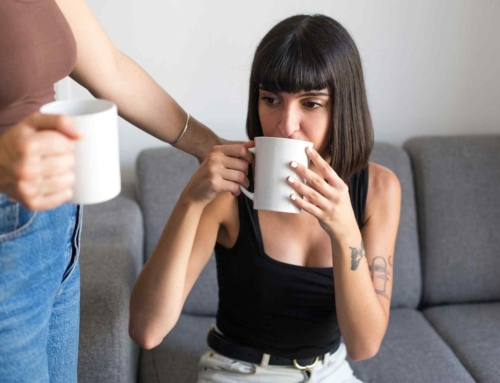 We’ve all had those days. There’s a big exam on the horizon, your first date with a person you’ve had a crush on for the longest time, a job interview, or the first day of class. These and many other situations can understandably create anxiety. Perhaps this has been your experience. The situation came and went. On your second date, you were far less nervous, the second day of class was way more relaxed, and you moved on with your life.
We’ve all had those days. There’s a big exam on the horizon, your first date with a person you’ve had a crush on for the longest time, a job interview, or the first day of class. These and many other situations can understandably create anxiety. Perhaps this has been your experience. The situation came and went. On your second date, you were far less nervous, the second day of class was way more relaxed, and you moved on with your life.
For other people, that’s not how it works. Anxiety for them seems to be more of a constant companion. How can you tell if your anxiety is a problem and goes beyond the usual physiological response people typically have to stressful situations?
Signs of anxiety
Anxiety affects a person’s body, emotions, and mind. When a person is in danger, their sympathetic nervous system kicks into high gear to help them either fight or flee from the situation. Your body redirects blood flow from organs that don’t need it at that moment toward your muscles, your heart rate increases, and your senses are heightened.
This is the body doing what it is supposed to be doing to protect itself from harm. The problem with anxiety is that the body starts to react as though it is being threatened, and in a life-and-death situation when it is an everyday matter such as setting foot outside your door. These physical, emotional, and mental effects can linger long after the danger has passed, and they can begin to disrupt daily living. Agoura Christian Counseling can help address these anxiety-related challenges by providing support and strategies to regain a sense of peace and control.
Some common physical and emotional symptoms of anxiety include:
- increased or profuse sweating
- having headaches or other aches and pains like backache
- breathing rapidly
- increased or irregular heart rate
- panic attacks, which produce an intense and overwhelming sensation of fear. This fear brings several symptoms of anxiety with it, including a fear of losing control, rapid heartbeat, profuse sweating, shortness of breath, shaking, a tight chest, fear of dying, and nausea
- nausea
- fatigue
 irritability
irritability- grinding your teeth (especially at night)
- muscle tension
- restlessness, and feeling on edge
- changes in your libido or sex drive
- upset stomach
- difficulties with sleeping, whether it’s falling or staying asleep
Some of the mental signs of anxiety include:
- excessive worrying about your anxiety, such as wondering when the next attack of anxiety may strike, struggling to stop worrying, or fearing that bad things might happen if you stop worrying
- seeking reassurance from your loved ones, and being consumed by the worry that people may be angry with you
- difficulty with concentration, and disruptions in your short-term memory
- having deep and irrational fears of certain situations, places, or objects
These physical, mental, and emotional symptoms of anxiety may not singly hint at anxiety. For example, feeling irritable or having fatigue may not by themselves indicate anxiety. Some other medical conditions, such as depression or other mental health conditions may also have those as symptoms.
When combined with other symptoms, such as excessive worry, that may point strongly to anxiety as the cause. It is important to go to your doctor or other qualified mental health professional and have them diagnose you after a thorough review of your symptoms to decide if you’re suffering from anxiety.
When these symptoms are present and worsen over time to the point where they begin interfering with your day-to-day life, and this happens on most days over about six months, it may be classified as an anxiety disorder.
What can you do about anxiety?
Anxiety can get in the way of a person living their best life and walking in the fullness of life and joy that God has promised his people (John 10:10). There are several ways one can deal with it, using both natural methods, or looking into therapy and medication.
- Eating healthy, fresh food, which helps your overall health.
- Limit caffeine and alcohol, as these can exacerbate the symptoms of anxiety and anxiety disorders
- Get exercise, like running, swimming, yoga, or walking, to relieve tension and release chemicals such as endorphins that increase your feelings of well-being
- Practice mindfulness, through techniques such as meditation, to relax your mind
- Sleep well, to allow your body to repair itself and reduce some of the physical symptoms of anxiety
- Use muscle relaxation techniques, to relieve the tension in your body and relax
- Know your triggers, the objects or situations that bring about an anxious reaction and reduce your interactions with them.
Therapy for anxiety may include techniques such as Cognitive Behavioral Therapy (CBT), which is the most widely used therapy for anxiety disorders. CBT is aimed at your thoughts, helping you to identify and understand negative thinking and ineffective behavior patterns, replacing these with more realistic and healthy thoughts, along with more effective actions and coping mechanisms.
 Another technique related to CBT that a therapist might use is Exposure Therapy, where your therapist will slowly expose you to anxiety-producing situations or objects. This is often done using systematic desensitization, a technique with several steps such as relaxation (where you’ll learn relaxation techniques such as deep breathing and meditation).
Another technique related to CBT that a therapist might use is Exposure Therapy, where your therapist will slowly expose you to anxiety-producing situations or objects. This is often done using systematic desensitization, a technique with several steps such as relaxation (where you’ll learn relaxation techniques such as deep breathing and meditation).
You will learn to name and list the things that trigger your anxiety; and work progressively through the list you created, either through imagining the thing that causes anxiety, facing the situation in real life or via virtual reality where live exposure isn’t possible).
Medications may be prescribed for anxiety and anxiety disorders, depending on their type and severity. These may address the physical and mental symptoms of anxiety and include:
Tricyclics, such as imipramine and clomipramine which are effective for most anxiety disorders other than Obsessive-Compulsive Disorder (OCD)
Anti-depressants, such as Selective Serotonin Reuptake Inhibitors (SSRIs) like fluoxetine and citalopram are a choice that has fewer side effects than older anti-depressants. They may have side effects such as nausea and sexual dysfunction at the beginning of treatment

Benzodiazepines, such as diazepam or valium, can be highly addictive and so they are rarely used as a first-order medication. To get these medications, one needs a prescription.
Other medications may be prescribed, such as beta-blockers, and Monoamine Oxidase Inhibitors (MAOIs) may also be effective in dealing with anxiety and anxiety disorders.
The effect of the medications may differ depending on the medication and the dosage your doctor prescribes. It may be tempting to stop taking the medication if it seems to not have an effect at the outset of the treatment or to stop soon after it begins having a positive effect.
It is important to keep your doctor updated with your symptoms and the side-effects of the medication so that the dosage or the medication can be changed to better suit your needs and treatment plan. Do not stop taking medication except at the direction of your doctor or other qualified mental health professional.
Getting the Help You Need
Anxiety is something that affects all of us on some level. For others, however, it can harm their quality of life and sense of well-being. When it devolves into anxiety disorders, that means the mental, emotional, and physical symptoms of anxiety have begun affecting them over prolonged periods, and they are hurting their day-to-day functioning.
Thankfully, there are solutions such as therapy and medication to help people cope. Whether you or your loved one has been journeying with anxiety, there are ways to reclaim the abundant and peaceful life God intended for people and to walk in joy instead of fear. Agoura Christian Counseling offers compassionate support and faith-based guidance to help you navigate anxiety and find healing and peace.
Christian psychotherapy, in addition to therapy techniques such as CBT, will bring the twin gifts of prayer and God’s wisdom in Scripture to bear on your situation and restore you to health.
“Cherry Blossoms”, Courtesy of J Lee, Unsplash.com, CC0 License; “Lonely Tree”, Courtesy of Theo Eilertsen Photography, Unsplash.com, CC0 License; “Cactus and Flowers”, Courtesy of David Sola, Unsplash.com, CC0 License; “Journaling”, Courtesy of Marcos Paulo Prado, Unsplash.com, CC0 License
-
Shirley Kauffman: Author
As a Licensed Marriage and Family Therapist, I provide faith-based counseling for individuals, couples, and families facing a wide range of issues including anxiety, depression, marriage problems, divorce, and other family issues. With God’s help, I’...
-
Kate Motaung: Curator
Kate Motaung is the Senior Writer, Editor, and Content Manager for a multi-state company. She is the author of several books including Letters to Grief, 101 Prayers for Comfort in Difficult Times, and A Place to Land: A Story of Longing and Belonging...
DISCLAIMER: THIS ARTICLE DOES NOT PROVIDE MEDICAL ADVICE
Articles are intended for informational purposes only and do not constitute medical advice; the content is not intended to be a substitute for professional medical advice, diagnosis, or treatment. All opinions expressed by authors and quoted sources are their own and do not necessarily reflect the opinions of the editors, publishers or editorial boards of Stone Oak Christian Counseling. This website does not recommend or endorse any specific tests, physicians, products, procedures, opinions, or other information that may be mentioned on the Site. Reliance on any information provided by this website is solely at your own risk.






